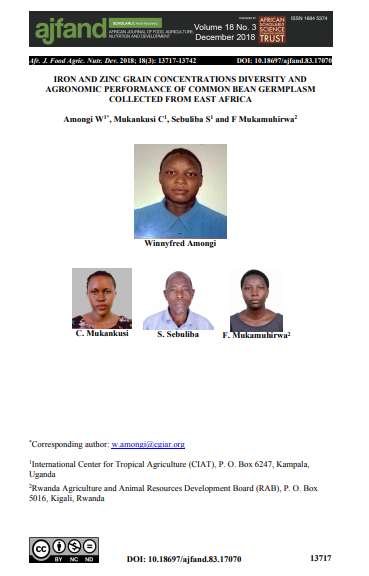Iron and zinc grain concentrations diversity and agronomic performance of common bean germplasm collected from East Africa
Summary
Iron and zinc are essential micronutrients for normal human growth and development and are commonly deficient in the diets of the most vulnerable. Common bean (Phaseolus vulgaris L.), one of the leading staple foods in East and Central Africa, is a valuable source of quality protein and micronutrients, specifically iron, zinc, and vitamins. Natural variation in micronutrient concentration exists among bean germplasm. Identification of varieties with high iron and zinc seed concentration (FESEED/ZNSEED) for promotion in food systems and utilization in breeding programs is one strategy of addressing the problem of malnutrition in Africa. Three hundred and four lines sourced from the International Centre for Tropical Agriculture (CIAT) and its partners through the Pan Africa Bean Research Alliance (PABRA) were evaluated for agronomic traits, disease response, yield, FESEED, and ZNSEED. They were organized in four groups: PABRA fast track, Rwanda seeds of hope, HarvestPlus regional nutrition nursery, and Uganda collection. Six checks were included: a universal high FESEED climbing bean (MIB465), a low FESEED regional climbing bean (Decelaya), a universal low FESEED bush bean (DOR500), a regional high FESEED bush bean (RWR2154), and two yield checks (CAL96 and Vuninkingi for bush and climbing bean). The FESEED checks were selected based on their relative performance to other genotypes in several experiments by a community of bean breeders through the H+ program. Field trials were established at the National Agricultural Laboratories, Kawanda from 2011 to 2013. Days to maturity and flowering, vigor, yield, and reaction to diseases were evaluated. Micronutrient analysis was conducted using X-Ray Fluorescence (XRF) and data confirmed using Inductively Coupled Plasma Atomic Emission Spectrometry (ICP-AES). Lines were significantly different (P≤0.05) in all the parameters assessed. FESEED and ZNSEED varied highly between seasons and among the entries ranging between 36–90 ppm and 24–47 ppm across the four nurseries. Twenty-six lines were selected as high iron beans (HIBs) based on XRF data; 12 of these were confirmed as HIB based on ICP data that is more accurate. Of these, two bush beans, Jesca (large purple speckled) and RW547 (medium grey) and two climbing beans, CAB2 (medium white seeded) and Ndimirakaguja (small cream), were the most superior in FESEED across seasons. With the exception of CAB2, these lines were relatively high yielding >2000 kgha-1. There was no significant correlation of FESEED or ZNSEED to yield. Nonetheless, FESEED and ZNSEED positively (0.59) correlated indicating that selection for superiority in one variable would result in a high value in the other.
Open resource Download resource

